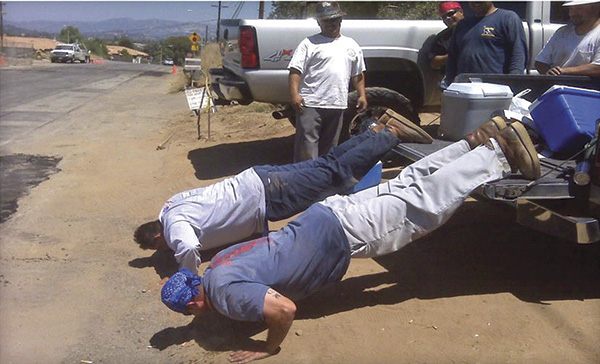
It’s no secret—construction is hard work that requires unrelenting physical and mental toughness. Whether you’re in the field or behind a desk, men and women who take on a career in construction must exert high levels of physical and mental energy to consistently meet industry demands. Construction is tough, and your employees need to be tougher. A fit, powerful team is the foundation of a high-performing company that reaches its greatest potential. Follow these rules to get the most out of your employee-wellness initiatives.
Make it competitive. In the right environment, people can harness their powerful energy as a vehicle to attain wellness success. Some people thrive in competitive, robust environments, so standard social weight-loss and bite-size corporate wellness programs just won’t cut it. Give your crew something they can sink their teeth into: competition, contests and challenges that motivate and drive them to achieve both individual and company-wide greatness.
Keep it simple. In the construction field, you and your employees are always on the go. Of course, you want to save on health care costs, but your employees don’t have time to track their calories, fill out spreadsheets with daily step counts or attend multiple health and wellness seminars throughout the year. Your wellness program should, therefore, leverage technology that allows even the busiest people to participate from anywhere, at any time. Participants need to be able to play along from their cellphones or home computers, checking in before/after work or during their breaks. Wireless tracking devices also act as the ultimate referees in workplace competitions, making each contest fun, fair, validated and regulated. By incorporating technology into your health program, you eliminate the hassle and legwork of traditional corporate initiatives. Remember—an effective health and wellness program aims to increase productivity, not interrupt it.

Spread the word. In a fast-paced atmosphere, communication techniques can make or break a team (even an entire company). With much of your team on the jobsite, communicating important information to everyone in a timely manner can be difficult. Employee health should be a top priority that demands a foolproof communication strategy—one that is customized to your company’s demographic needs. An effective communication strategy incorporates email, posters, flyers, health calendars, pre-shift announcements, manager-initiated group activities and online alerts.
Walk the talk. As a visible leader, your job is to establish and commit to upholding company standards. Deciding exactly how to implement a corporate wellness program and choosing which groups to include can be difficult. Is the program designed only for those on medical plans? Is it for full-timers only or part-timers too? Your wellness program always should be offered to 100 percent of full-time employees, whether or not they elect medical coverage. Part-timers and dependents/spouses are important to include as well. Why? Because employee wellness affects more than just medical claims—it impacts job performance, productivity, absenteeism, company culture and morale. Just as a chain is only as strong as its weakest link, a company’s success is determined by the successes of its employees from the top down. Lead the wellness revolution by example. You might be surprised how much your open involvement pushes others to join.
Buddy up. Getting healthy shouldn’t add to your stress—it should be energizing and should relieve your stress. Your corporate wellness initiatives should encourage teamwork and camaraderie, which build and improve company culture. Organized, health-based challenges create synergies that allow employees to work together, compete and communicate in ways they otherwise would not. Mix up your teams with each competition to build an even deeper layer of communication.
Spread your focus. Wellness is a valuable employee benefit, but let’s face it—you’re still concerned with how it affects the bottom line. Health care costs are rising at an unsustainable rate, so construction companies are making employee health and wellness a strategic business initiative—encouraging healthy employee behaviors to curb health care costs while creating a more efficient workforce. True ROI is likely your ultimate goal, but implementing a corporate wellness program is about more than just health care savings. Construction is among the most demanding industries, requiring ingenuity, persistence, strength and endurance. Healthy employees are more productive, stronger, less likely to injure themselves and require fewer sick days than their unhealthy coworkers. Plus, studies show that healthy people are actually happier overall—both at work and at home. So, while employee wellness is certainly a viable way to save some cash, it’s also a powerful tool that can help build a team of top producers.
